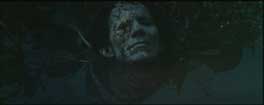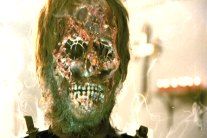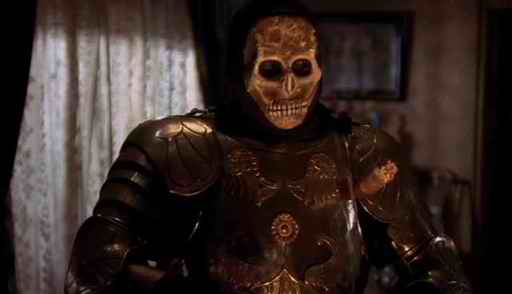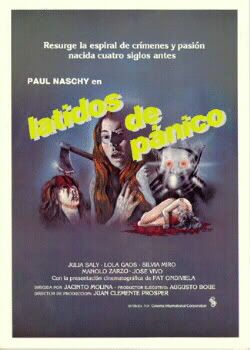When I was younger, during the summer my family used to vacation in Martha’s Vineyard (or Island Vacation, as I’ve been known to call it), a little island filled with the rich, a lot of hippies and the vacationing nearly poor (like us). I’m not really a beach person and neither is my dad so what we would do most days is head to the one place that has remained consistently excellent on Martha’s Vineyard (my increasing resistance to dairy making their top-notch ice cream parlours and clam chowder less and less attractive an option as the summers wore on) their independent video store. Island Video may just be my favorite rental place in creation. As a 12 year old I was stoked to see the titles that filled our Psychotronic video guide and the Encyclopedia of Monsters lining it’s racks. There like manna from heaven were battered VHS copies of
Chopping Mall, My Bloody Valentine, Ticks, and Italian films I’d never even heard of (I was only 12 and hadn’t yet subjected myself to the rigour of Mario Bava and his followers’ vast canon). So when we returned to Martha’s Vineyard for the first time after a lengthy absence, I knew I had to make my few trips to Island video count. The first trip I filled with a whole mess of foreign films (
Salvatore Giuliano, Alf Sjoberg’s
Miss Julie, and
Before The Rain being just a few). The second trip, the one I’d been saving, I got two zombie films I’d been searching for the better part of two years.
Shock Waves
by Ken Wiederhorn

Nazi zombies. Is there anything that warms your heart more? I think it speaks to this film’s quality as a family film that I was able to watch this with my girlfriend (granted it was only because we were playing a card game and I refused to turn the TV off) Not the usual Italian schlock fest, but in fact an American production shot in Florida with an inventive young director. That’s going to go a long way toward the film’s quality. The first thing we need to understand is that the zombies are not your typical post-Romero shamblers a la
Night of the Living Dead, nor are they the runners filling up so many post-
28 Days Later straight-to-DVDs. No these are special zombies. If you watch
Zombie Lake and wonder why their zombies are so….special, it’s because the geniuses at Flora Film (director Jean Rollin included) saw
Shock Waves and paid attention to its zombie’s behaviors. Ken Wiederhorn, as it turns out, is a much better filmmaker than Jean Rollin (so’s half of the world at large, but that’s neither here nor there) and
Shock Waves is logically a much better film than its many impersonators. This may or may not be because it had a lot of coincidental things going for it – the presence of real actors, a spooky locale, and decent make-up – as Wiederhorn hasn’t exactly proved himself to be the a reliable director. Since
Shock Waves, his biggest success has been
Return of the Living Dead part II, which while not as bad as the man will tell you it is, isn’t half as good as
part I.
Our story starts at sea. A boat, which we’ll learn to be a not-quite-up-to-code yacht, is experiencing some difficulties. It could be that its captain (John Carradine) is about 115 years old and is no fit state to be taking tourists anywhere. The boat’s sonar and radio are no longer working because of some kind of meteorological phenomenon (the sky’s gone all warped-looking, what else could it be?). Things really go south when their boat is struck by an even bigger boat, nearly sinking it, the captain goes missing and then the boat catches on the shoals of an island (not unlike the
Elizabeth Dane, now that I think about it). The crew (which is two other guys, Keith and Hobbs) has to abandon the thing and take the small group of passengers with them. The passengers are Norman and Beverly, a bickering old married couple, Chuck, an out-of-shape bachelor, and an inexplicable gorgeous woman called Rose (more on her later). As they enter the shallows of the island, the captain floats beneath the glass bottom of the boat, dead as every mad scientist John Carradine has ever played. This puts a more sinister spin on what was simply an inconvenience a few hours ago. So with their boat beached, and the captain dead, our crew treks inland to do some exploring.
They find what appears to be a long abandoned resort hotel of some kind. Abandoned for 44 years in fact (the year’s 1977, before you begin scratching your head). Well, there’s a Peter Cushing character here to clear things up for us. Turns out this was a secret resort for the Reich way back when and was to be the launching point for a supreme fighting force at the start of the US’s involvement in World War II, but the boat they were in capsized in the shoals (sound familiar?) when Pete crashed it, terrified of the implications of being caught with a boat full of super soldiers. Now, when our host tells his damp charges to run for their lives, what do you suppose he knows that they don’t? Maybe it’s something to do with the vengeful Nazi zombies beneath the waters that are surfacing at that very moment. These guys were a big, spooky deal. I like to think that they would have been the resultant fighting force if Tsiang the priest from
Revolt of the Zombies had sold his zombie soldier formula to Adolph Hitler instead of being killed. Our host wanders off and meets a bad end at the decomposed hands of some moist villains. And when Peter Cushing gets his you know everyone else is pretty well done for. The cast and their hiding places whittle from here.

What makes this film so special is of course its zombies (isn’t that always the case?). With make-up done by Alan Ormsby (star of
Children Shouldn’t Play With Dead Things, make-up artist on
Deathdream) its no surprise that they look great despite the films budget. These guys are a pretty menacing presence in that they run around breaking shit looking for their prey whenever they aren’t administering the beatdown. They don’t just wander either, they move with purpose and can really put on a burst of speed when they sense people are nearby. Ready for the kicker? They can’t see and for once, that means something (unlike
Tombs of the Blind Dead). They wear spooky welder’s goggles and mostly operate by listening for movement. When our heroes pull the glasses off an attacking zombie, he becomes disoriented and loses his momentum. And because they zombies freethinking and determined, we’re treated to some suspense, something I had assumed the makers of low budget zombie films had forgotten about by 1977. And because Ken Wiederhorn understands suspense, it follows that he knows a thing or two about characterization and that means we get more than one likable protagonist, a few really effective hide ‘n seek set-pieces and an ending that had me biting my nails despite my knowing the outcome. In other words,
Shock Waves has flaws, but it’s about the best drive-in movie you’re likely to find.
And let’s give credit where credit is due. This is behind a reasonable doubt a drive-in film. Filmed in Florida with John Carradine and Peter Cushing? This was made to be seen in the back of an El Camino, no two ways. Both men were paid $5000 for four days work and the hotel they filmed in cost $250 for the entirety of the 35-day shoot. There is virtually no gore and many of the performances are predictable and wooden, but it makes a lot out of a little. What makes this film especially interesting to me, as both a fan of the best and worst kinds of film, is that it features one Brooke Adams before stardom had a chance to come and go. She’s the cute hero in this film, and I for one am curious how all that worked out. Brooke Adams made precious few movies in her career, not the least of which were Philip Kaufman’s excellent remake of
Invasion of the Body Snatchers and Terrence Malick’s
Days of Heaven. She went from nothing to something overnight and then faded into obscurity and left a few pretty amazing performances behind her in two of the best films ever made. But before all that,
Shock Waves. People can’t often spring out of the world of drive-thru horror, but Brooke managed to. We all have to start somewhere, I guess. She does a great job in
Shock Waves, but…its still
Shock Waves. Curious. Her performance was just one of a few pleasant surprises to be found in this film.

Don’t listen to me though. After watching both
Shock Waves and Paul Lynch’s
Humongous, my Girlfriend declined to watch the next film with me.
Shivers
by David Cronenberg

The apartment building OF-THE-FUTURE has just opened and is taking on boarders. We’re informed of this vis-à-vis the opening voice over by a super confident real estate agent telling a couple of newlyweds about the virtue of this spiffy new apartment complex. As he’s giving his pitch, we see a scientist, Dr. Hobbes, strangling his mistress to death. When he’s certain she’s dead, he cuts her open and pours acid into her guts before cutting his own throat…WHAT THE FUCK? That’s an opening I wasn’t expecting. The scene is treated with a sterile sort of emotional detachment that makes it all the more unsettling (no music, no words from the doctor, white walls, etc.).
Bet you’d like to know why Dr. Hobbes just made your brain shut down, wouldn’t you? Well Hobbes has been conducting experiments, and like those conducted by every cinematic mad scientist, it isn’t exactly on the level, and as his colleague Linsky tells him, he’s out of his gourd. When you hear what he’s up to, you’ll be singing in the Linsky choir, too. Hobbes has been experimenting with parasites. His research has ostensibly to do with transplants, but what winds up happening is that Hobbes contempt for modern man winds up influencing his parasite. Because Hobbes thinks that humans have lost sight of the flesh and its pleasures, his parasite is both a Spanish Fly and an STI. Once the parasite, which is a heinous worm thing the size of a hotdog roll, has worked its way inside you, your sex drive increases and then you become violent and then your brain function vastly deteriorates and you become a violent sociopath hell-bent on killing. Now this doesn’t all come out at once, we have to learn it slowly like the residents of the apartment complex do as they each have encounters with slug victims in varying states of depravity. The apartment’s resident physician Roger St. Luc (there’s a Canadian name for you, eh?) and his nurse Forsythe have to identify and combat the infected people as things rapidly get out of hand. After a number of thoroughly icky scenes, the halls are filled with slug zombies and Roger finds himself outnumbered and outgunned.

Cronenberg deserves props if for no other reason than his refusal to make the same kind of film everyone else was making.
Shivers is a much better zombie film than half of those made in the 1970s, resembles none of them and nearly obfuscates the best of them. It’s conscious indictment of modern society feels very much like a precursor to
Dawn of the Dead while it’s sober tone and thrilling third act feel like evocations of
Night of the Living Dead and
The Crazies (that it shares a leading lady and a disease of a sexual nature with the latter film makes the connection hard to deny). The difference between
Shivers and
The Crazies other than a more cohesive edit is that Cronenberg was giving sexual infection a tangible form and made rape the product of a malicious parasite rather than mental illness – both are fitting comparisons, but Cronenberg’s feels like the more incisive of the two (this is probably because Romero was making a film about the infectiousness of violence and repression and not about sexuality in bourgeois society, which meant he couldn’t focus his film on one topic like Cronenberg could). Anyway,
Shivers is about as creepy as zombie films got in the 70s and also as thoughtfully composed. Most films can barely keep it together just being zombie films (
Toxic Zombies, Garden of the Dead, Vengeance of the Zombies), and have no energy or coordination left to try and give you a message. Shivers does both. And as usual the man missed the point. The film was given a beating in the press by conservative journalists who felt that the government’s money could be spent on nobler projects than this. Their main issue was with the film’s sexual content and violence, which, granted, were plentiful. The reason they are there is to comment on society, not gross it out. Cronenberg used the most visceral tools at his disposal as an amateur filmmaker to elicit a response from his audience, and because the message went right over conservatives’ heads, they latched onto surface features. You can get behind condemning sexuality if you don’t understand why it’s ludicrous to do so. Post-modern commentary wasn’t something found in your average horror film, so it’s no surprise that critics missed the point – let’s not forget that the press was still reeling over
I Spit On Your Grave when
Shivers hit them in the groin.

I was surprised to figure out a little later on that this was David Cronenberg’s first proper film. Lacking the scope of something like
Rabid, the assured weirdness of
Scanners or
Naked Lunch or the gore-or-locations mentality of
The Fly or
Videodrome, Shivers, like
The Brood is a little film that feels big. It also has some of the craziest imagery to be found in a zombie film - the ending orgy in the pool being just one of the great visuals this film contains. It’s budget brought about excellent gore effects, which are underplayed by Cronenberg, and some remarkable performers, not the least of which is Barbara Steele.
Shock Waves may have had both Carradine and Cushing, but I call that nothing next to the Giallo scream queen showing up in a tiny Canadian production for a first time director. I would have given the film curio points for featuring Lynn Lowry, one of my favorite character actors, doing her PTS shtick, though, unlike her turns in
The Crazies and
I Drink Your Blood, she has lines this time and proves she’s good for more than that haunting feline stare. Coincidentally or not, she and Alan Ormsby wound up together for Paul Schrader’s
Cat People, which Ormsby wrote and Lowry plays a minor role as a prostitute mauled by a panther. I love that horror films are a self-contained family affair. But the real draw for fans of the genre has to be Steele. Listening to Cronenberg, who is something like the Peter Bogdanovich of Horror films, on the DVD’s interview track talking about how they achieved her level of energy is really fascinating. At Steele’s behest Cronenberg would slap her repeatedly until she was sufficiently emotional to do her takes. When one of the crewmembers caught them ‘rehearsing’ Cronenberg nearly had the film taken away from him. But he kept it and made a film that doesn’t want for creepiness, originality and claustrophobia (there’s a bathtub scene that’s been ripped off as many times as Hitchcock’s). And as a nice bonus for zombie history buffs,
Shivers represents the first entry in the slug-zombie subgenre, something I’d been curious about since seeing James Gunn’s
Slither.
The film itself is a minor miracle. As I was saying,
Shivers feels like the work of a crew with ten times the budget. Exuding a professionalism I’d liken to both Zach Snyder’s
Dawn of the Dead and George Romero’s
Dawn of the Dead, Shivers builds a thoroughly frightening timebomb of a plot and manages to do so in what could be the same set used a dozen times over. We rarely leave the apartment complex and yet Cronenberg’s script makes that a point in the film’s favor as he uses the environment’s few facets to build on the horrific story. He also gives the randomness of things an urgency to it, so the fact that we never know who’s in on it and who’s not is made all the creepier. When finally we’re given that all important scene zombies breaking down doors en masse, it’s really effective as its not only scary, but it heaps on more chaos onto an already scattered story. A much less sloppy film than
Rabid, which followed two years later and bears no little resemblance to its predecessor, Shivers lacks a bit of that film’s emotional involvement as it has no male lead with the sympathetic edge of someone like Frank Moor or Art Hindle (who coincidentally plays Brooke Adam’s husband in
Invasion of the Body Snatchers). His films are best when we see the everyman thrust into some circumstances that could charitably be described as ‘trying’. Shivers is told like a series of related vignettes, rather than as a cohesive whole, which hints more at Cronenberg being a first time director more than anything, as he never told a story the same way. His films became much more personal soon after and would center on strong male leads in tragic relationships with slightly weaker women almost 100% of the time (he’s only just given a woman as strong a role as a man in his latest
Eastern Promises).
Anyway,
Shivers is a remarkable film and went on to be Canada’s most successful film at the time and the fact that Cronenberg had only two unsettling student films to his name shows his extraordinary promise; It hints at the many great nightmare worlds to come from its creator. In fact the film has a line of dialogue, fittingly delivered by Lynn Lowry that nicely sums up the ethos of all of Cronenberg’s films:
“I had a very disturbing dream last night. In this dream I found myself making love to a strange man. Only I'm having trouble you see, because he's old... and dying... and he smells bad, and I find him repulsive. But then he tells me that everything is erotic, that everything is sexual. You know what I mean? He tells me that even old flesh is erotic flesh. That disease is the love of two alien kinds of creatures for each other. That even dying is an act of eroticism. That talking is sexual. That breathing is sexual. That even to physically exist is sexual. And I believe him, and we make love beautifully.”
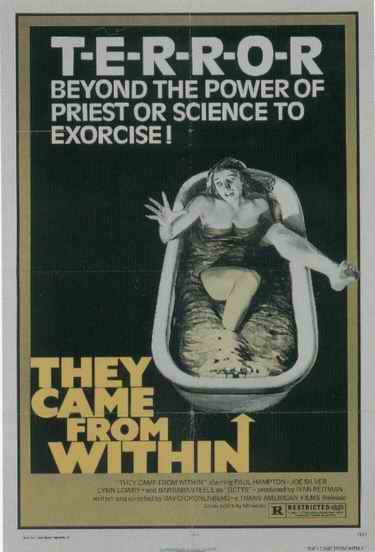
In its wake Cronenberg and his movie were so lambasted that he was actually kicked out of his apartment (sort of poetic, if you wanna be a smart aleck) and was almost denied future funding to make his next film. And that is scarier than any zombie movie.














